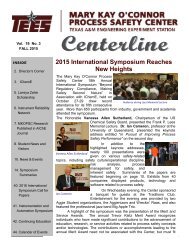Engineer
H02g9QM0
H02g9QM0
You also want an ePaper? Increase the reach of your titles
YUMPU automatically turns print PDFs into web optimized ePapers that Google loves.
strain cycles as it is deployed<br />
and retrieved. Additionally,<br />
the coiled tubing will undergo<br />
dynamic fatigue loading during<br />
operation from the vessel<br />
motions and interaction with<br />
the sheave. The geometry of<br />
the sheave will dictate both the<br />
strength and fatigue response<br />
of the system. A smaller sheave<br />
radius will induce the following:<br />
1. Increased low cycle fatigue<br />
damage induced from reeling<br />
during deployment and retrieval;<br />
2. Increased residual stresses<br />
in the suspended region of the<br />
coiled tubing;<br />
3. Increased strains in “on<br />
sheave” section of the coiled tubing<br />
induced by vessel motions.<br />
As a recommendation, the minimum sheave diameter should<br />
be 48 times greater than the outer diameter of the coiled tubing,<br />
as per NORSOK D-002 Section 7.5. This sizing ratio provides a<br />
good balance between the system footprint and coiled tubing<br />
structural performance.<br />
The critical sheave locations (A, B, and the fatigue hotspot)<br />
are shown in Figure 2. When calculating the fatigue response<br />
at each location, the peel-off effect must be correctly modeled.<br />
If it is assumed that the coiled tubing is tangent to the top and<br />
side of the sheave at Point A and Point B, the fatigue hotspot<br />
would, in theory, instantly transition from having a finite<br />
curvature to having infinite curvature. This would result in a<br />
fatigue life measured in minutes rather than weeks at Point B.<br />
In actuality, the stiffness of the coiled tubing causes a much<br />
more gradual “peel off” region. The points of peel off initiation<br />
are identified with green arrows in Figure 2.<br />
A fatigue hotspot, existing just below Point B, is the location<br />
where failure is most likely to occur. Detailed analysis of<br />
the fatigue hotspot is suggested before operations commence.<br />
As discussed above, the fatigue hotspot will experience<br />
low cycle fatigue (defined as 1000<br />
cycles to failure) during its service life. Calculating high and<br />
low cycle fatigue independently from each other<br />
is routinely performed. However, this approach 10<br />
can underestimate the fatigue capacity of the<br />
system, and correctly accounting for combined<br />
high and low cycle fatigue is critical in this<br />
application.<br />
1<br />
Miner’s Linear Damage Rule is a linear method<br />
of combining fatigue damage, which is useful if<br />
the damage is in the same fatigue domain (high<br />
or low cycle).<br />
0.1<br />
However, Miner’s rule becomes inaccurate<br />
when combining low and high cycle fatigue.<br />
Therefore, its sole use is not appropriate when<br />
analyzing riserless subsea pumping systems. Two 0.01<br />
fatigue damage summation rules which are useful<br />
for combining high and low cycle fatigue are<br />
discussed below.<br />
oedigital.com<br />
Fatigue<br />
hotspot<br />
Peel off<br />
initiated<br />
B<br />
To subsea<br />
stackup<br />
True Strain Amplitude (%)<br />
A<br />
Sheave<br />
Figure 2 – Critical pipe<br />
locations on the sheave.<br />
To reel<br />
Non-linear fatigue<br />
combination methods<br />
The power rule and other nonlinear<br />
damage summation laws<br />
can be used to convert the low<br />
cycle reeling fatigue into an<br />
equivalent high cycle fatigue<br />
damage rate. This equivalent<br />
high cycle fatigue damage can<br />
be summed using Miner’s rule<br />
with the high cycle operational<br />
fatigue damage to provide an<br />
overall fatigue damage. High<br />
cycle and low cycle fatigue must<br />
be calculated independently for<br />
these damage summation rules<br />
to be applicable. The power rule<br />
and other non-linear damage<br />
summation laws are experimentally<br />
fit curves and require some<br />
material testing. The power rule<br />
is fit to the material type and geometry<br />
through the use of an exponent, p. When no experimental<br />
data is available, the power law can still be used by assuming<br />
a conservative p-value.<br />
Additionally, the power rule requires knowledge of the loading<br />
sequence to be used. This is suitable for riserless well intervention,<br />
however, because the load sequence is predictable.<br />
Assuming all low cycle fatigue damage occurs prior to any high<br />
cycle fatigue damage will result in a conservative fatigue damage<br />
accumulation value.<br />
Periodic overload curve<br />
While the power rule and other non-linear fatigue damage accumulation<br />
laws only serve to combine high and low cycle fatigue,<br />
the periodic overload approach takes into account the effect of<br />
the overload cycles (reeling cycles) on the operational cycles.<br />
The periodic overload strain-life curve is developed using tests<br />
that apply periodic overloads at regular intervals so that all the<br />
applied small cycle stress/strain ranges are fully effective. When<br />
the specimen fails, an equivalent fatigue life for the small cycles<br />
can then be obtained using a derivative of Miner’s rule.<br />
An effective strain-life curve accounting for periodic overloading<br />
is thus generated. This curve is represented by the red<br />
curve below the blue constant amplitude strain-life curve in<br />
Constant Amplitude<br />
Periodic Overload<br />
1.E+01 1.E+02 1.E+03 1.E+04 1.E+05 1.E+06 1.E+07 1.E+08<br />
Equivalent Reversals to Failure<br />
Figure 3 – Periodic overload strain-life curve.<br />
Content is copyright protected and provided for personal use only - not for reproduction or retransmission.<br />
For reprints please contact the Publisher.<br />
February 2016 | OE<br />
33



